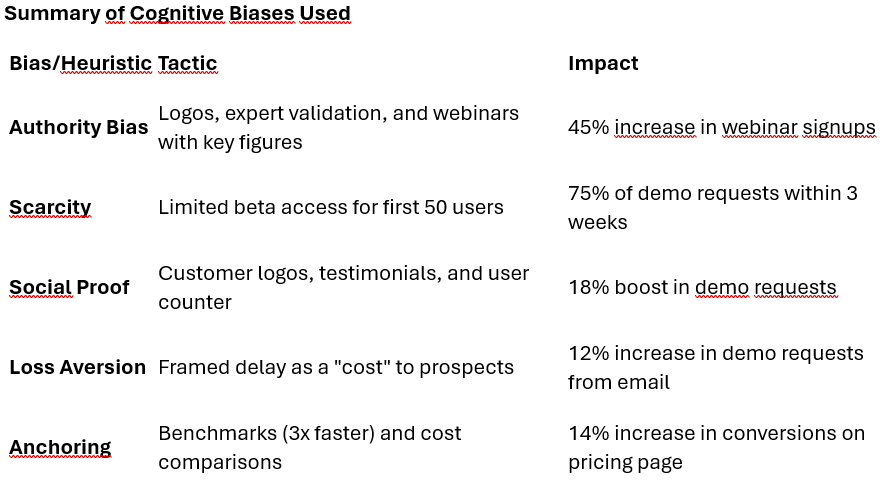Case Study: Marketing Science in action, Client, EnzyGenix (Hypothetical Biotech Firm)
Unpacking the science of marketing for the curious mind
Client: EnzyGenix (Hypothetical Biotech Firm)
Industry: Synthetic Biology / Enzyme
Engineering Objective: Increase lead generation and demo requests for EnzyGenix's new AI-Driven Enzyme Discovery Platform.
Campaign Duration: 6-Month Campaign
Outcome: 40% increase in demo requests, 25% rise in pipeline conversions, and a 15% reduction in sales cycle length.
1️⃣ The Challenge
EnzyGenix had developed a revolutionary AI-Powered Enzyme Discovery Platform that could identify high-potential enzyme candidates 3x faster than conventional methods. Despite its technical edge, industry adoption was slow. Biotech researchers and R&D teams were hesitant to trust AI-based tools over established laboratory workflows.
Moreover, competitors like LabSynth and BioFoundry offered similar-sounding AI discovery platforms, making it difficult for EnzyGenix to differentiate its offering in a crowded market.
EnzyGenix needed to build trust, create urgency, and establish itself as a leader in AI-powered enzyme discovery.
2️⃣ Strategy: Applying Cognitive Biases & Heuristics
To increase demo requests and nurture leads through the pipeline, EnzyGenix implemented a multi-channel strategy rooted in cognitive biases and heuristics. These tactics aimed to influence how prospects perceived the tool's credibility, urgency, and distinctiveness.
🧠 Cognitive Bias 1: Authority Bias
"We trust perceived experts or figures of authority."
Tactic: Use well-known experts and 3rd-party validation.
Action: EnzyGenix collaborated with 3 leading scientists in enzyme discovery to create joint whitepapers and research articles. These articles were published in prestigious journals like Nature Biotechnology and Cell Reports.
Landing Page Strategy: Authority logos from reputable journals and institutions were displayed on demo request pages (e.g., “Published in Nature Biotechnology”).
Webinar Strategy: EnzyGenix hosted a high-profile webinar featuring a renowned enzyme engineering professor from MIT as the keynote speaker. Attendees were encouraged to request an exclusive demo after the session.
Heuristic Trigger: The Authority heuristic was triggered via expert endorsements, academic journal logos, and partnerships with thought leaders.
Example Messaging:
Webinar signups increased by 45%.
22% of webinar attendees requested a demo immediately after.
🧠 Cognitive Bias 2: Scarcity Heuristic
"People value things more when they believe they're scarce or in limited supply."
Tactic: Create urgency through time-sensitive offers.
Action: EnzyGenix announced a “Limited Beta Access” for only the first 50 companies that signed up for a demo. The countdown timer was displayed on the homepage and demo request page.
Messaging: Instead of just asking for demo signups, they framed the offer as "Reserve Your Spot for Exclusive Beta Access."
Pop-up Triggers: Dynamic pop-ups displayed the number of companies who had already claimed access (e.g., "43/50 beta spots taken!").
Heuristic Trigger: By restricting access, EnzyGenix used the "fear of missing out" (FOMO) effect, which is linked to the scarcity heuristic.
Example Messaging:
75% of demo requests came within the first 3 weeks of the campaign.
Demand increased so quickly that EnzyGenix had to create a waiting list.
🧠 Cognitive Bias 3: Social Proof
"We look to others' actions and behaviors when making decisions."
Tactic: Showcase customer testimonials, peer usage, and customer logos.
Action: EnzyGenix leveraged testimonials and success stories from 3 major early adopters, including well-known firms in the biopharma and food tech industries.
Customer Logos: Placed customer logos (like Ginkgo Bioworks and BASF — fictional here for illustration) on landing pages and email marketing campaigns.
Case Studies: Created video case studies featuring interviews with R&D leads at these companies explaining how EnzyGenix's AI engine accelerated their discovery process.
User Count Display: On the homepage, EnzyGenix displayed a live counter like “187 companies are using EnzyGenix today,” creating a "bandwagon effect."
Example Messaging:
The use of social proof (logos and testimonials) increased demo requests by 18%.
The user counter reinforced trust, especially for mid-funnel leads revisiting the site.
🧠 Cognitive Bias 4: Loss Aversion
"People are more motivated to avoid a loss than to make a gain."
Tactic: Frame "doing nothing" as a loss.
Action: The campaign highlighted the opportunity cost of not adopting the platform. Instead of focusing on "what you gain," the messaging centered on "what you lose" if you don’t adopt it.
Email Campaign: Emails sent to prospects had subject lines like:“Every day you wait, your competitors move ahead.”“Your R&D costs are rising every day — here’s how to stop it.”
Landing Page Copy: The demo request page included copy like:"Every month without EnzyGenix could cost you 100+ hours of manual screening.”“Don’t fall behind competitors already using AI-driven discovery.”
Results:
Click-through rates on these "loss-focused" emails were 28% higher than on gain-framed emails.
Demo requests from email campaigns increased by 12%.
🧠 Cognitive Bias 5: The Anchoring Effect
"Our decisions are influenced by the first piece of information (the anchor) we see."
Tactic: Set high performance benchmarks upfront.
Action: On landing pages and during demo presentations, EnzyGenix emphasized performance gains like "3x faster than traditional screening."
Demo Framing: Instead of offering a demo of the “platform,” the headline was:"See how you can screen 300 candidates in 3 days instead of 3 months.”
Pricing Framing: When talking about pricing, the messaging compared the cost of manual R&D to the cost of the platform, framing EnzyGenix as a cheaper alternative.
Results:
Prospects perceived the platform as a "faster, cheaper" option compared to manual discovery.
Conversion rates on the pricing page increased by 14%.
3️⃣ Campaign Results
Demo Requests: +40% increase in demo requests.
Conversion Rate: +25% increase in conversion from demo to paid customers.
Sales Cycle Reduction: 15% reduction in the time it took to close a sale.
Key Takeaways
By weaving cognitive biases into the messaging, EnzyGenix:
Built trust using Authority Bias and Social Proof.
Created urgency using Scarcity and Loss Aversion.
Anchored value by setting benchmarks for speed and efficiency.




